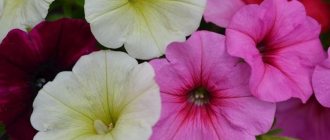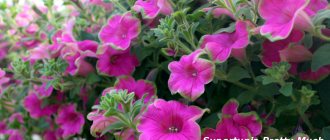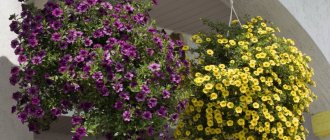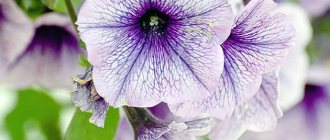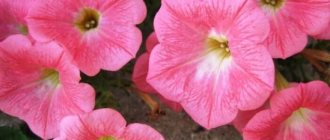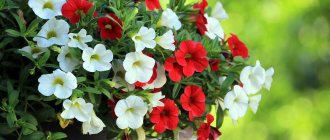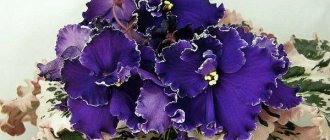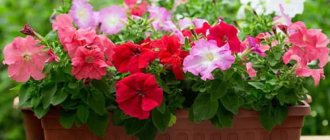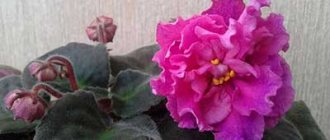One of the most unpretentious and frequently used objects in landscaping is petunia. Landscape designers often use petunia in decoration and create beautiful and at the same time quite durable compositions. These delicate plants were noticed and appreciated back in the 19th century, and then breeders developed several varieties of ornamental petunias. There are still many new hybrids emerging, with larger buds, longer stems and other improved characteristics.
We’ll tell you more about the benefits of landscaping and which varieties of petunia you should choose in this article!
Petunia - description and features
Petunia (or petunia - both spellings are possible) belongs to the genus of herbaceous or subshrubby perennial plants of the Solanaceae family. The height of wild plants varies from 10 cm to 1 meter. Petunia is native to the tropical regions of South America and also grows in Paraguay, Argentina, and Bolivia.
Petunia star
Biological description
The stems of the plant are either erect or creeping, densely branched, with the formation of shoots of the second and third orders. The height depends on the variety and varies from 20-30 cm to 60-70 cm. The leaves are of different sizes, pubescent, of various shapes and colors. The inflorescences are often large, although there are also small-flowered petunia varieties, single, simple or double. The fruit is a capsule and cracks when the seeds ripen.
Benefits of petunias in landscaping
Petunia is extremely popular in landscaping. The abundance of hybrids of different shapes, sizes and shades of flowers allows you to decorate flowerpots, flower beds, gazebos, and other objects. Thanks to their dense foliage and small growth, petunias form a thick and lush carpet.
Petunias in cafe design
The plant has a number of advantages:
- Unpretentiousness and adaptability to various conditions. For this, she is very loved in Russia and even in Siberia and the northern regions she blooms beautifully.
- Long flowering period.
- A huge number of shades, which allows you to create beautiful compositions.
- Versatility - these flowers look equally good in carpet flower beds, hanging flowerpots and multi-tiered flower beds. In addition, petunias are in perfect harmony with other ornamental plants - pelargoniums, fuchsias and even juniper and thuja.
Petunias play a major role in the design of the Dubai Garden of Wonders, which is considered the eighth wonder of the world. Entire houses, towers, and pyramids are decorated with petunias here. They are combined with geranium, calendula and coleus.
Petunia "Black Triumph" large-flowered
What types of petunias and where is best to place them: designer tips
Landscape designers recommend using various forms of petunias for landscaping:
- on loggias, balconies, front areas and patios, large-flowered varieties of petunia, which are planted in pots or containers, would be appropriate;
- varieties of the multi-flower group are suitable for decorating borders; they will create a dense and dense planting;
- It is better to decorate the facade with small-flowered varieties, and if some of the inflorescences are damaged, it will not be noticeable;
- for planting in flower beds and large flower beds, it is better to take abundantly flowering petunias, and hanging containers will look great with hanging varieties.
Petunia Cascade Burgundy
Landing algorithm
Petunia Starry Sky (photos and reports from flower-growing enthusiasts are classified as fairly heat-loving plants) is planted in open flower beds no earlier than the threat of night frosts has passed. The usual time for bringing petunias out into the air is the last week of May or the first ten days of June.
Cuttings and seedlings of the Starry Sky are planted according to similar rules. The planting dates for them are also selected in the same way. Planting in flowerpots can be done much earlier, and then the petunias can be grown on a closed loggia.
The process of transplanting petunia seedlings:
- It is advisable to take Starry Sky out into the open ground in cloudy weather.
- Sprouts are considered ready for planting if they have at least 5 true leaves.
- The holes are made about 10 cm deep, leaving at least 30 cm between the seats.
- The roots of the plants are carefully transferred into the depressions along with a lump of earth or a peat tablet.
- Sprinkle the missing soil and lightly press the surface with your palm.
- The flowerbeds are watered abundantly and then mulched with crushed peat, tree bark or chopped grass.
In sunny weather, Starry Sky seedlings need shading for several days. After the petunias have adapted to the flowerbed, the shelter can be removed.
Types of petunias
All petunias can be divided into groups according to several characteristics.
According to the shape of the bush
- Bush ones - they can be either low and compact, or spreading - up to 50-75 cm. When growing, it is recommended to pinch the shoots to stimulate branching. Most varieties tolerate wind and rain well.
- Ampelous - characterized by flexible and long shoots. In some hybrids they reach 150 cm. Most of the ampelous varieties are characterized by resistance to unfavorable conditions and bloom for a long time. However, long stems suffer from gusts of wind, so when placing them it is better to choose protected places. They are placed in hanging pots from which the shoots hang down beautifully.
- Cascade - similar to ampelous ones, but differ in shorter and less flexible stems. They grow upward and bend only under the weight of their own shoots. They, like hanging ones, are good to place in vertical flower beds, hanging flowerpots and boxes.
Petunia grandiflora Double Cascade Orchid Mixed
According to the shape of flowers
- Simple - have smooth edges. One bud has 5 fused petals. Such petunias are usually planted in flower beds and used for landscaping parks, squares, and alleys. They look simple, but at the same time very beautiful.
- Terry - created by breeders and have more than 5 petals. Their number varies depending on the variety. Most often, the petals of terry petunias are corrugated, which gives them a special splendor. Such flowers look equally impressive both in flower pots and in flower beds. But when growing them, you should remember that their flowers are very delicate and easily damaged. If the summer is damp and cool, then the flowers may begin to rot from waterlogging. Among terry species, new varieties of petunia have recently appeared.
Multi-flowered petunia Dot Star Dark Vilit F1
By flower size and flowering pattern
- Abundantly flowering (floribunda). This is a whole group of petunias, which are distinguished by large flowers measuring 6-10 cm with long and lush flowering.
- Multi-flowered (multiflora). This group includes varieties and hybrids that are distinguished by abundant flowering, for example, the magnificent Dot Star Dark Vailite of star color. The group includes both compact and spreading varieties. Flowers can be simple or double, 4-5 cm in diameter.
Petunia multiflora Dot Star Deep Pink F1
- Typically, plants of this group are unpretentious, bloom early, bloom for a long time and are characterized by rapid recovery after rains. Most often they are planted in flower beds and containers.
- Small-flowered (milliflora). Sometimes they are also called mini-flowers. They are distinguished by very small flowers, but there are many of them on one plant. The main advantages of this group of petunias are abundant flowering and resistance to adverse weather conditions. Milliflora forms a small bush, quite compact. They are often planted in small flowerpots, boxes, and flower beds.
- Large-flowered (grandiflora). For example, Blue butterflies. The varieties and hybrids of this group are very loved by gardeners. Plants are short-growing (25-35 cm) or tall (up to 70 cm), and flowers are formed up to 13 cm in size, depending on the variety. The peculiarity of large-flowered petunias is their poor resistance to adverse weather conditions - rain, wind. Therefore, they are recommended to be used for landscaping balconies, terraces, and verandas.
Petunia grandiflora Postion Blue F1
In the descriptions of varieties you can find several characteristics at once. Petunia can be both double and large-flowered. Thanks to selection, a rich palette of colors has appeared, which allows any gardener or landscape designer to find something they like.
Petunia grandiflora Daddy Shuga F1
Read on - we’ll tell you about the varieties of petunia and show photos of them.
Petunia (P. x hybrida) is used in cultivation Wilm.) - garden hybrids, the starting materials for which were axillary petunia (P. axillaris
(Lam.) B. S. P.)
and violet petunia
(P. violacea Lindl.),
currently not grown.
| Petunia 'Dreams' Photo of Slavic Estate |
The plant is a perennial, cultivated as an annual.
Stems are erect or creeping, densely branched, 20-70 cm tall, round, green. The leaves are sessile or on short petioles, whole, of various sizes and shapes, arranged in an alternate order. Stems and leaves have a specific odor and are covered with simple and glandular hairs. The root system is shallow, taprooted, branched, the plant well forms adventitious roots from the lower part of the stem. The flowers are solitary, on strong short stalks, located in the axils of the leaves. The number of flowers on a plant can be very large. The flower consists of a perianth, a pistil with a funnel-shaped stigma on a thin style and five free stamens, the anthers of which are located at the same level, slightly below the stigma of the pistil.
The perianth is double, five-membered, with a funnel-shaped regular fused-petalled corolla. The diameter of the flowers is 5-12 cm. The corolla is folded, in many varieties it is velvety. The edge of the petals can be smooth, wavy or corrugated. The flowers are most often single.
The color of the flower and unpretentiousness have made petunia very popular. The entire spectrum of pure colors, except green, is complemented by endless shades, various veins and spots in the middle of the flower. There are not only blue petunias, but there are dark blue and velvet purple ones. Petunias with contrasting colors are especially elegant: white stars or a white border on a dark blue or red background.
Flowers can be varied in shape. The edges of the petals are smooth, fringed or corrugated. All the elegance of a petunia flower, of course, is collected in double flowers; you simply cannot take your eyes off them, but they are also the most capricious to grow. In many varieties and hybrids, the main background of the petals has darker veining, which becomes more intense towards the center of the flower.
In general, the petunia flower is the most beautiful, but also the most vulnerable part of the plant. The flowers are damaged by rain, and in prolonged wet weather they rot. In modern hybrids this deficiency has been practically corrected. In addition, if you place plants taking into account their resistance to rain, then stops in flowering can be practically avoided. It is advisable to plant petunia already blooming in May and it will bloom until frost. Bears fruit. Gives self-seeding. In culture since about the middle of the 19th century.
As already noted, all modern varieties and hybrids of petunias can be divided into several groups according to the size and appearance of the flowers, as well as the height and shape of the plants.
| Petunia 'Daddy' Photo of Slavic Estate | Petunia 'Daddy mix' Photo of Slavyanskaya Usadba | Petunia f. pendula Photo of the Slavic Estate |
Multi-flowered petunia
Varieties and hybrids of this group are distinguished by an abundance of medium-sized flowers. This is the most unpretentious, cold-resistant, rain- and wind-resistant, early-blooming petunia. Plants of modern F1 hybrids resemble flowering balls, and in a flower garden they form a continuous carpet. The varieties are less decorative, as they usually have a spreading bush shape.
multi-flowered low compact (f. multiflora nana compacta) - plants 20-35 cm tall, smooth flowers 5-6 cm in diameter, bloom 70-75 days from sowing;
multi-flowered low double (f. multiflora nana flore pleno) - plants 30-40 cm high, flowers 6-7 cm in diameter, smooth, bloom 70-75 days from sowing;
A small number of variety series and individual F1 hybrids of multifloral petunia are grown in the world. Below is a description of some of them.
FANTASY [Fantasy]. Originator: Goldsmith, USA. Series of 9 F1 hybrids. The height and diameter of the plants is 20 cm, the diameter of the flowers is about 4 cm. The color of the flowers is blue-violet, raspberry-pink, red with a white throat, salmon, pink with a red throat and veins, pale pink with a yellowish-white throat, white, crimson- red, pale salmon with dark veins.
MERLIN [Merlin]. Originator: Sakata, Japan. A series of compact abundantly flowering hybrids F1 Plant height 25 cm, flower diameter 6.5 cm. The series includes 9 hybrids with different flower colors: blue-violet, carmine pink, pink, red, light pink, salmon, white, red with a white border , purple with a white border.
CARPET [Carpet]. Originator: Pan American, USA. Series of 14 hybrids. It is characterized by early flowering, low growth, compactness, heat resistance and resistance to gray rot. The coloring is very diverse, including lemon yellow.
PRIME TIME [Prime Time]. Originator: Goldsmith, USA. A series of F1 hybrids that meet all modern requirements. The diameter of the flower is about 6 cm. The plants are compact, flowering profusely. Some hybrids have a wavy petal edge. There are 15 colors in the series - traditional single-color or with darker veins, as well as two-color (white star on a colored background).
'Summer Sun' [Sammae San]. Hybrid F, with unusual yellow flowers. Flowers with a diameter of 5-7 cm. Plants are compact, early flowering. Flowering is not very abundant.
'Plum Crystals' [Plum Crystals]. Hybrid F. Flowers with a diameter of about 7 cm. Plant height is 30 cm, bush diameter is 25 cm. The color changes over time: immediately after the bud opens it is pink-lilac, then light lilac, and at the end of flowering it is pale lilac. Numerous burgundy-violet veins contrast with the main color. In the flower garden, this variety goes well with silver-leaved plants.
MIRAGE [Mirage]. Originators: Pan American and Walz. The series consists of 13 F hybrids. The plants are compact. Double flowers, diameter 6-9 cm. Color: pink with dark pink veins, coral, blue-violet, pink-lilac with dark veins, lilac-pink with purple veins, pink, red, crimson, pink with crimson-red veins, pale lilac with violet-burgundy veins, red with burgundy veins, raspberry-burgundy, white.
'Bonanza' MIXED [Bonanza Mixt]. A mixture of hybrid origin with double flowers, 10 colors. Plant height 30 cm.
'Cardinal' [Cardinal] - F1 hybrid with double brick-red flowers.
'Cherry Tart' [Cherry Tart] is one of the best F hybrids in the group, with double cherry-red flowers with a white border.
'Plum Double' [Plum Double] - F1 hybrid with double light lilac flowers with violet-burgundy veins.
'Red and White Delight' [Red and White Delight] - F1 hybrid with double two-color (white and red) flowers.
Petunia floribunda
Occupies an intermediate position between multi-flowered and large-flowered. The plants have many relatively large flowers, which, like Petunia multiflora, are slightly damaged by rain. It is most advisable to use varieties and hybrids of this group for large flower beds, since this petunia is most effective only in bulk.
SONJA [Sonia] - one of the popular variety series, includes 11 F1 hybrids. Plant height 25 cm. Flower color: blue-violet, pink, raspberry-burgundy, raspberry-burgundy with a white star, light purple with purple veins, pink-lilac with lilac-burgundy veins, red with a white border, crimson, raspberry-pink with white star, red, white.
CELEBRITY [Silebrity] - a series of F1 hybrids. It is heat and rain resistant at the same time. There are 13 colors: white with blue veins, pink-lilac with burgundy veins, raspberry-pink with a yellowish-white center, raspberry with dark veins, pink with dark pink veins, salmon-red with dark veins, blue-violet, lilac, dark red, raspberry, red, salmon, white.
Large-flowered petunia
The most popular group, numbering hundreds of varieties and hybrids with very large and beautiful flowers, but having significant disadvantages in our climate - poor rain resistance of flowers and a relatively small number of flowers per plant. In petunia grandiflora, the flowers are damaged by any rain or strong wind, and the plants temporarily lose their decorative properties. Highlight:
large-flowered (f. grandiflora) - a spreading bush up to 60 cm tall, the flowers are smooth, 8-10 cm in diameter, bloom 80-90 days from sowing;
large-flowered low (f. grandiflora nana) - a compact bush 25-30 cm tall, smooth flowers, 8-10 cm in diameter, bloom 80-90 days from sowing;
large-flowered fringed (f. grandiflora fimbriata) - bush 60-75 cm tall, large flowers with a narrow tube, fringed along the edge, 10-12 cm in diameter, bloom 85-95 days from sowing;
large-flowered fringed low (f. grandiflora fim-briata nana) - compact bush 25-35 cm tall, flowers 10-12 cm in diameter, fringed along the edge, bloom 85-95 days from sowing;
large-flowered superb (f. grandiflora super-bissima) - spreading bush, 50-75 cm tall, large flowers, up to 12 cm in diameter, with a smooth or wavy edge, wide tube with a mass of darker colored veins, bloom on 85-95 days from sowing;
large-flowered superb low (f. grandiflora superbissima nana) - compact bush 30-40 cm tall, large flowers, 10-12 cm in diameter, smooth edges, wide throat with a mass of darker colored veins, bloom 85-95 days from sowing;
large-flowered double (f. grandiflora flore pleno) - spreading bush 50-60 cm tall, flowers large, double, with a smooth or fringed edge, 10-12 cm in diameter;
The most popular series and hybrids are:
HIT PARAD [Hit Parade]. The originator of the series is Senary, Germany. Fast flowering hybrids. Plant height is 25 cm. Almost the entire range of colors is presented: blue-violet, pink, crimson, salmon, whitish-pale-lilac, white, raspberry-burgundy; white star on a blue, red, raspberry-red and raspberry-burgundy background.
DADDY [Daddy]. Originator: Pan American, USA. A series of six F1 hybrids. A distinctive feature is dark-colored veins, contrasting with the main color of the petals. Plant height is 30 cm. Color is light purple, pink-lilac, pink, red, lavender.
PICOTEE [Picotee]. Originator: Goldsmith, USA. Series of 4 hybrids. A distinctive feature is the strongly corrugated edge of the petals and a white border up to 1.5 cm wide. The height of the plants is 25 cm. The main colors of the flowers are: red, pink, crimson, purple, violet-blue.
HULAHOOP [Hula Hoop]. Originator: Sakata, Japan. The F1 series of hybrids is similar to PICOTEE, but has wavy rather than ruffled petal edges. In addition, plants in this series bloom much earlier (by 12 days).
FALCON [Falcon]. Originator: Sakata, Japan. Series of 18 F1 hybrids. The height of the plants is 25 cm. The flowers are varied in color - there are both plain colors and colors with contrasting dark veins. Some hybrids have flowers with a corrugated edge.
HIGHLIGHT [Highlight]. A series of F1 hybrids with medium-sized flowers and high rain resistance. Their distinctive feature is the presence of a white spot in the center of the flower. Hybrids are ideal for outdoor flower beds. The color of the flowers is brick-red, pink, blue-violet, raspberry-red, coral.
STORM [Storm]. Originator: Goldsmith, USA. A series of hybrids is distinguished by a small diameter of flowers, but greater resistance to atmospheric influences. Plant height is 30 cm. In our country, the hybrid F1 'Lavender Storm' with a bluish-lilac color of flowers is most often grown from this series.
POLARIS [Polaris]. Originator: Nutting & Sons, Ltd (UK). A series of 13 F1 hybrids have been bred for rainy Britain. This is one of the earliest flowering series. The plants are compact, the flowers remain decorative for 5 days. The color of the flowers is monochromatic and two-color (violet with white, purple with white, red with white, pink with white, pink with yellow).
FLASH [Flash]. Originator: Sluis & Groot. A series of 11 F1 hybrids with medium-sized flowers, resistant to weather conditions. The plants are very neat and even in habit. The color of the flowers is blue-violet, white with a blue star, coral, pink, purple with a white star, red, raspberry-pink, raspberry with a white star, salmon, wine red with dark veins, white.
ULTRA [Ultra]. Originator: Goldsmith, USA. The F1 series of hybrids is distinguished by a very compact habit, early flowering, and weather resistance. The color of the flowers is traditional and two-tone (with a white star).
DREAM [Dream]. Originator: Pan American, USA. A series of five F1 hybrids are resistant to adverse weather conditions. Flowers are white, pink with a yellowish throat, red, salmon with a white throat, light purple. The plants are low-growing, compact, and fit well together.
ENSIGN [Ensign]. Series of hybrids F1 for universal use. Flowers with a diameter of 10-11 cm. A distinctive feature is the ability to bloom in the open air longer than other petunias. There are 6 main colors in the series: blue-violet, pink, crimson, red, salmon, white.
TITAN [Titan]. Series of 9 F1 hybrids. The diameter of the flowers is up to 12 cm. The height of the plants is 30 cm. They can be used for planting both in the flower garden and in flower pots. The color is blue-violet, dark red, violet-blue, red, raspberry-pink, crimson, salmon, white, red with a white star.
'Prism Sunshine' [Prism Sunshine] - F1 hybrid with lemon-yellow flower color. Originator: Floranova. Plant height 25 cm.
'Red Morn' [Red My] - F1 hybrid with flowers of original color: brick-red with a yellowish-white center, the edge of the petals is strongly corrugated. Plant height 30 cm.
'Purple Pirouette' [Pyople Feasts] - F1 hybrid with double flowers having corrugated petals with fringe along the edges; color is violet-purple with a white border. Plant height 25 cm.
'Lyric' [Lyric] - F1 hybrid with double salmon-pink flowers.
'Salmon Bouquet' [Salmon Bouquet] - F1 hybrid with double salmon-pink flowers, 8-9 cm in diameter, the edge of the petals is fringed.
'Bridal Bouquet', 'Sonata' [Bridal Bouquet] - F1 hybrids with double white large flowers.
'Blue Danube' [Blue Danube] - F1 hybrid with double lilac-blue flowers. Plants are compact.
'Nocturn' [Nocturn] - F1 hybrid with double blue-violet flowers.
'Valentine' [Valentine] - F1 hybrid with double red small flowers.
'Fanfare' MIXTUR [Fanfare Mixt] - a mixture of hybrid origin with double flowers. Plants are low growing. The color of the flowers is one-color and two-color. One of the most popular mixtures in the group of double large-flowered petunias.
'Allgefiillter Zwerg' [Algefiillter Zwerg] - F1 hybrid with double spherical flowers of bright noble colors. Plants are low, compact, 25 cm high, early flowering. Can be used for planting in flowerpots.
'Duo Double' MIXED [Duo Double Mixt] - a mixture of hybrid origin. Plants are 25 cm high. The flowers are double, reminiscent of a double carnation, the color is one-color or two-color.
Since many breeding and seed companies offer almost the same type of series of large-flowered petunia, it is difficult for seedling producers and flower growers to give preference to one series or another. In Table. The results of tests of the most popular series and individual hybrids conducted in Germany are presented.
| SERIES or hybrid | Originator | Beginning of flowering | Rain resistance of flowers, score (from 1 to 9) | Abundance of flowering, score (from 1 to 9) | Color fastness of flowers, days |
| HIT PARAD | Senary | 10.05 | 8 | 6 | 8 |
| PRELUDE | Clause | 10.05 | 6 | 6 | 9 |
| ULTRA | Goldsmith | 10.05 | 5 | 6 | 8 |
| NEW SUPER MAGIC | Pan American | 11.05 | 8 | 6 | 4 |
| SUPER FLAGGE | H.Meisert | 11.05 | 5 | 6 | 11 |
| POSTILLION | Royal Sluis | 12.05 | 7 | 6 | 10 |
| STERN | Erf. Samenz. | 12.05 | 6 | 7 | 12 |
| EXPRESS | Walz | 13.05 | 8 | 8 | 12 |
| FLASH | Sluis & Groot | 14.05 | 8 | 8 | 11 |
| PRIO | Royal Sluis | 14.05 | 7 | 7 | 6 |
| FROST | Goldsmith | 15.05 | 7 | 6 | 2 |
| TRAUM | Goldsmith | 15.05 | 5 | 6 | 12 |
| 'Peppermint DADDY' | Pan American | 5.05 | 7 | 8 | 1 |
| 'Lacy Sails' | Goldsmith | 12.05 | 7 | 6 | 1 |
| 'Saturn' | Goldsmith | 18.05 | 8 | 6 | 1 |
| 'Velvet PICOTEE' | Goldsmith | 18.05 | 7 | 6 | 1 |
Notes: Sowing: 24.02; pick: 19.03; transshipment: 23.04; arrangement 7.05; implementation period: from 10.05 to 22.05. The rain resistance of flowers was determined based on the results of observations for June - September: 9 points - the most rain-resistant flowers. Abundance of flowering: 9 points - the most abundant flowering hybrid.
pendulous (f. pendula)
(Surfinia, Tumbelina, Supertunia, etc.) - drooping stems, 80-90 cm long, flowers 6-7 cm in diameter, smooth edges, bloom 70-75 days from sowing.
In the last decade, heterotic hybrids have become widespread. Their assortment is large, there are more than 500 varieties. Many foreign seed companies have completely switched to their cultivation. All of them are distinguished by early and abundant flowering, compact growth and resistance to unfavorable growing conditions.
Examples of varieties:
'Abendsonne' - (large-flowered, fringed, low form). The bush is erect, 30-45 cm tall, densely branched, with numerous shoots of the first order. The shoots are green, densely pubescent. The leaves are large, irregularly ovoid, green, pubescent. The flowers are simple, large, up to 8 cm in diameter. The funnel is bright crimson-pink with a dense mesh pattern of dark veins, the edges are strongly fringed, bent down. The tube is medium-sized, pink-beige inside with brown veins, densely pubescent. The seeds ripen poorly.
'Admiral' (low multi-flowered form). The bush is erect, 30-35 cm tall, spreading, densely branched. The shoots are green, pubescent. The leaves are small, rounded, heart-shaped, green, densely pubescent. The flowers are simple, up to 6 cm in diameter. The funnel is five-toothed, dark purple, velvety, with smooth edges. The tube is narrow, purple, with dark purple veins. The seeds are ripening.
'Alphons' - (form of superbissim). The bush is spreading, weakly branched, up to 70 cm tall. The leaves are large, rounded, kidney-shaped, dark green, pubescent, and clustered. The flowers are simple, large, up to 9 cm in diameter. The funnel is dark crimson-purple with dark veins with a strongly fringed edge bent downwards. The tube is wide, dark purple inside, silky with dark purple veins, densely pubescent. The seeds ripen poorly.
'Brilliantrosa' - (large-flowered fringed form). The bush is erect, 60-65 cm tall, densely branched. The shoots are light green, densely pubescent. The leaves are rounded-ovate, green, pubescent, and clustered. The flowers are simple, large, up to 9 cm in diameter. The funnel is bright pink with a mesh pattern of dark veins, with a fringed edge bent down. The tube is medium-sized, pink, pubescent on the outside.
'Weisse Wolke' - (large-flowered form). The bush is compact, erect, 35-45 cm tall, densely aerated, with numerous green, pubescent shoots. The leaves are large, rounded, kidney-shaped, dark green, and clustered. The flowers are simple, large, up to 10 cm in diameter. The funnel is star-shaped, white, with yellowish-green veins, slightly wavy. The tube is medium-sized, yellow-green inside, dark green outside, densely pubescent.
'Wurtemberger' - (form of superbissim). Straight bush up to 65 cm tall, weakly branched. The shoots are light green, densely pubescent, ribbed at the base. The leaves are very large, heart-shaped, green, with a slightly wavy blade, pubescent. The flowers are simple, very large, up to 10 cm in diameter. The funnel is red-purple with a reticulate pattern, dark purple at the base with light purple veins, and beet-like on the outside with convex radial dark veins. The seeds ripen poorly.
'Cockatoo' ('Kakadu') - (low multi-flowered form). The bush is erect, about 30 cm tall, densely branched. The shoots are light green, pubescent. The leaves are small, round-oval, light green. The flowers are simple, up to 5 cm in diameter. The funnel is jagged, purple with white spots along the edge, the edges are smooth and rounded. Variegated and monochromatic flowers bloom simultaneously on one plant. The tube is narrow, dark purple. Fruits abundantly.
'Rheingold' - (form of superbissim). The bush is erect, spreading, 45-50 cm tall, weakly branched. The shoots are green, densely pubescent. The leaves are large, kidney-shaped, green. The flowers are simple, large, up to 9 cm in diameter. The funnel is pure white with a greenish-yellow, strongly wavy, bent down edge. The tube is wide, yellow-green inside with a mesh pattern of green veins. The seeds ripen poorly.
One of the most famous and widely used groups is grandiflora, which occupies more than half of the assortment of petunias. A distinctive feature of the varieties of this group is their very large flowers of various shapes and colors. They seem to be created in order to admire the beauty and grace of each individual flower.
They are usually planted in containers or flowerpots installed on balconies, loggias and patios. They look lovely in flower beds and ridges near the lawn, pond or path. But, like many beauties, the varieties and hybrids of this group are quite capricious: they are heat-loving, require careful care, and the flowers are very delicate and suffer greatly from winds and rains. Therefore, they are planted in Russian conditions, as a rule, in the warmest places protected from bad weather. Terry varieties are especially capricious when cultivated. In rainy and cool weather, their flowers begin to rot and flowering stops. Therefore, places for their cultivation must be chosen especially carefully.
The floribunda group is more resistant to bad weather and other adverse conditions. The varieties of this group occupy an intermediate position between large- and multi-flowered petunias, taking from the former elegant and rather large flowers of various colors, and from the latter - resistance to cold weather and rain. Therefore, varieties of this group are widely used for decorating large flower beds and arrays.
Varieties of the multiflora group, or multi-flowered, lack most of the disadvantages of large-flowered petunias. They are distinguished by earlier, surprisingly abundant and long-lasting flowering, and resistance to rain and cold snaps. The individual flowers of multi-flowered petunias are not as beautiful and elegant as those of large-flowered petunias, but compact bushes, completely covered with flowers, look simply charming. Taking into account the fact that modern F1 hybrids of multi-flowered petunia, among other advantages, are ideally aligned in habit, the growing interest of flower growers in this group becomes clear.
Most often, multi-flowered petunia is used in carpet plantings, for decorating large flower beds and arrays, especially in difficult environmental conditions of large cities. Petunias form beautiful borders and ridges, bright spots of color on lawns or along roads. In addition, flowering seedlings of multi-flowered petunia in early spring (in the second half of April - early May) decorate loggias, balconies, and are planted in containers near offices, shops, and cafes.
The best varieties of ampelous petunias: description and photo
Purple Falls
This is a highly decorative second generation species. It is characterized by abundant and beautiful flowering and tolerates rain, wind and hot weather well. The authors of this hybrid recommend using it for placement in hanging baskets, boxes on the balcony or in garden containers. The length of the ampels reaches 80-100 cm, they have a highly branched shape, and the stems are strong. The flowers are large up to 8 cm.
Black velvet
Elite variety, large-flowered. Plant height is about 25-35 cm, flower size is 8 cm in diameter. The bush is spreading, 25-20 cm wide, strongly branches. Flowering begins at the end of May and continues throughout the season until frost begins. Thanks to the bright, almost black color of the flowers, arrangements in hanging baskets and tall flowerpots look luxurious.
Petunia grandiflora Sophistica Blackberry
Rapunzel
An unusually beautiful and delicate plant with hanging stems fully lives up to its name. Young bushes are erect, but as they grow, under their own weight, they hang beautifully over the edges of the basket. Shoots grow up to 80 cm long. The variety is characterized by large flowers up to 8 cm in size, abundant flowering and sufficient drought resistance.
Possible problems
All problems and diseases of the Starry Sky petunia are caused, first of all, by improper care. How to avoid flower diseases?
- To prevent diseases or if there are signs of damage, it is necessary to regularly treat the leaves with special chemical compounds, having first studied the instructions.
- If petunia receives a lot of moisture and light, the leaves may turn yellow and the buds and flowers will begin to fall off. Adjust watering, do not get carried away with fertilizing, shade the location of the petunia.
- Make sure that when watering, the leaves and flowers do not get wet. Water only at the roots.
- The leaves are wrinkled, darkened - saturate the roots with moisture, they simply do not have enough water or the petunia is infected with viruses, inspect the flower carefully.
Many years of work by breeders has led to the emergence of a huge number of types of petunias, including bush, hanging and cascading. The varieties especially loved by flower growers are: Ramblin, Typhoon Silver, Wave, Gioconda, Opera and Surfinia.
Petunia “Starry Sky” has become popular among amateur and professional flower growers. This variety came to us from Europe quite recently. The reasons for its success are simple: unpretentiousness in nutrition and care, abundant unusual flowering. You can decorate a balcony, window sill, plant it in elegant flowerpots or decorate the walls with hanging flower pots.
The best terry varieties (photo)
Valentina
Large-flowered super-double variety. The flowers look like carnations, very bright, large and lush. The bushes reach a height of 40 cm, the flowers are very large - up to 12 cm in diameter. Flowering is long - from May to September. To stimulate flowering, plants are pinched. It is recommended to place Valentina in the center of large flower beds, as well as in large flowerpots.
Duo red and white
The flowers are 5-5.5 cm, externally similar to carnation buds. The bush is compact, strongly branches, the stems grow 25-35 cm long. Petunia blooms throughout the summer until the first frost, and is resistant to adverse weather conditions.
Boucle
Hybrid F1, characterized by abundant flowering. The flowers are double, 6-8 cm in diameter. The bush is compact, 35 cm high. The advantages of the Boucle hybrid are drought resistance, unpretentiousness, long and lush flowering.
Petunia in wooden flower pots
Pests and diseases
With improper care, there is a risk of developing diseases. The Starry Night variety is resistant to most infections. Powdery mildew and gray rot can damage the plant. These diseases are provoked by high air humidity and improper watering.
White coating on leaves is the main sign of powdery mildew.
Affected shoots must be removed to prevent infection of the entire flower. The bush should be sprayed with a fungicidal agent 2-3 times at intervals of 2 days. Garlic infusion is used as an alternative treatment option. To prepare 25 g of crushed cloves, pour 1 liter of water. The liquid is infused for several hours and then the plant is sprayed with it.
In open ground it is possible to be affected by the following pests:
- spider mite;
- aphid;
- thrips.
To combat insects, complex insecticides are used, for example, the preparations “Confidor”, “Aktara”. The flower is treated once a week 3-4 times. For preventive purposes, you can spray with copper sulfate twice a year. Another effective means of protection against pests is tobacco ash, which is buried in the soil next to the bush.
More details How ampelous petunia differs from cascading petunia
Small-flowered varieties (photo)
Dwarf F1
Plants are compact, 20 cm tall. Flowers are 4-5 cm in diameter. They bloom 9-11 weeks after sowing and bloom profusely. Plants are planted in pots and boxes to decorate balconies and loggias.
Carpet
The variety has more than 20 varieties of flower colors. There are both classic solid shades and more interesting ones, for example, with yellow veins on red and white petals, two-tone, with a white star on a bright background. Plant height is 25-35 cm, flower size is 6-7 cm. It is highly resistant to high temperatures, does not stretch, and is little damaged by rain and wind.
Balcony mixture
Falling stems up to 50 cm long. Flowers are small - up to 5 cm. Flower colors can be varied - red, pink, salmon, purple, etc. Plants are light-loving and drought-resistant. Ideal for growing in hanging pots and balcony boxes.
Advantages and disadvantages
Hybrid petunias Night Sky have gained wide popularity among gardeners. The flower has many advantages over other varieties.
Main advantages:
- unique decorative qualities;
- long flowering;
- resistance to diseases and pests;
- winter hardiness;
- ease of cultivation and care.
The disadvantage of the Starry Night variety is its high sensitivity to drought. Another obvious disadvantage is that the flower does not tolerate winter without shelter.
Tall and low-growing varieties (photo)
Tall varieties
They are usually placed in tall flowerpots so that the full splendor of the bush can be appreciated. Here are a few varieties that experienced gardeners recommend.
- Typhoon Cherry F1. This hybrid can be considered gigantic, as the length of the shoots reaches 1.5 meters! The flowers are small - only 5-6 cm. The root system is powerful, so it is recommended to plant this variety in flowerpots with a volume of at least 30 liters.
- Tidal wave parple. The length of the stems is slightly less than that of the Typhoon - about 90-110 cm, but with very good care they can grow up to 150 cm. The height of the bush is no more than 60 cm, the flowers are small - 5-7 cm. The hybrid is very popular among landscape designers and It is often used in compositions. Another difference of the variety is its good adaptability to different weather conditions.
- Opera Supreme Pink Morn. The length of the stems reaches 120 cm, while the bush grows in height by only 10-20 cm. It is recommended to plant in large flowerpots with a volume of at least 15 liters.
Low growing varieties
- Pirouette purple F1. The bushes are low - about 25 cm tall, and branch well. The flowers are densely double, with purple petals bordered by a white jagged stripe. Flowering period from May to October.
- Hula Hup. An elegant large-flowered variety with an abundance of shades and super early flowering. Compared to other large-flowered hybrids, this one blooms 12 days earlier. A bush with a large number of flowers, each 7.5-8 cm in size. The color is purple-blue with a white rim around the edge.
- Lambada. A small and compact plant up to 25 cm high. Blooms profusely from the beginning of May until the onset of frost. The flowers are small, 5-7 cm.
Petunia Lambada Burgundy
Reproduction methods
Petunia Night Sky reproduces exclusively by vegetative means . To do this, break off a stalk 10 cm long and place it in 100 ml of water. After the roots appear, 10-14 days later, the petiole is planted in a pot with a 200 ml peat substrate. The plant feeds on the leaf, since the root system is not yet sufficiently formed.
The cuttings are sprayed with water at room temperature twice a day and fed once with Kornevin (25 g per 10 liters of water).
After 14 days, a full-fledged rhizome is formed and increases its mass over the course of a month. A developed small bush is transplanted into a hanging container with a volume of 2-2.5 liters.
How to choose petunias
As you have already seen, there are a lot of names, hybrids and types of petunias. In order not to get confused and choose the right name for the petunia variety that will suit and delight you in the garden and on the balcony, use the following rules.
- Please note the manufacturer. The largest producers of petunia seeds are foreign companies. For example, Singenta, Farao, Sakata. In Russia, petunia seeds are practically not produced, and those that are sold by domestic companies are often packaged batches from other manufacturers. At the same time, packaging companies often change the original names to their own. And then it is already difficult to find a specific hybrid, since different packers may have different names for the same original variety. Therefore, it is best to look for stores that sell hybrids in the original manufacturer’s packaging, with the original name and recommendations for growing.
- Choose first generation F1 hybrids. These are the most spectacular petunias, which combine the best characteristics - abundance of flowering, shape of flowers and bush. Such seeds are sold in pelleted form individually. Usually 5 pieces, which are placed in a small test tube so that they are not damaged. F2 seeds – collected from plants grown from F1 seeds. And now they rarely retain varietal characteristics in full or do not retain them at all. Having bought F2 seeds, it is difficult to predict the result.
- If you want to buy cascading or hanging petunias, then choose only F1. Among simple petunias, there are no cascading or hanging petunias.
Petunia grandiflora Supercascade White
Well, to choose good varieties of petunia, pay attention to the expiration date of the seeds, as they quickly lose their viability.
All varieties of petunia are extremely beautiful and interesting, so even the most refined and demanding taste will be satisfied. In addition, new varieties of petunias are appearing, so the flowers are very popular among both amateur gardeners and professional landscapers and designers. LLC “Vashe Khozyaystvo” sells only original petunia seeds from the Czech producer Cerny. The original names of the manufacturer are indicated on the packages. In our catalog you can choose double (Pirouette), large-flowered (Tritunia Blue Star) and other types. You can view the catalog here!
Petunia Pirouette pink terry
A practical approach to selection
In order not to get confused in the huge number of species and varieties of petunias, you should determine in advance the guidelines that need to be emphasized when selecting planting material. First of all, formulate the task that petunia is called upon to perform, and also find out where it grows, which it will decorate with its presence.
Knowing the goal, it will be much easier to choose one or another plant variety.
Break the entire selection process into several steps. As you do this, try to answer a few of the following questions:
- Which petunia is ideal for your growth type - hanging or upright?
- Will the flower grow in open soil or in a closed container?
- How important is the size of the bushes and the length of the shoots: are you interested in large or miniature varieties?
- Is there a need for earlier flowering?
- Is there a goal to introduce petunia into a flower arrangement?
Finally, move from theory to practice. After all, the selection criteria are much more clearly illustrated by practice.
In accordance with the conditions of the future place of residence of petunias, the following type of flower will be suitable for a specific place:
- In a potted garden, bush plants are the best place, and in tubs, representatives of the hanging group will feel great.
- For impressive flowerpots, bush petunias are a good option.
- In common boxes and containers on balconies, bush hybrids will be very comfortable, but if the plant is needed to decorate the edge of the container, then cascading flowers will be the undisputed favorite.
- To decorate flower beds and garden beds, choose large-flowered grandiflora. Also in this case, creeping options will play perfectly.
- It is recommended to plant borders with dwarf or medium-sized petunias.
- When landscaping flowering walls and hanging gardens, it is recommended to choose hanging hanging varieties.
- And cascading petunias will decorate single hanging baskets.
Choosing a petunia variety may seem like a boring and useless process at first glance. But the main thing is not to forget about the purpose of the purchase and always listen to your taste.
Petunia is a perennial or annual plant
Before introducing you to the best varieties of petunia, I would like to note that in nature the plant grows in tropical countries, therefore it is perennial. In cultivation, petunias are grown as annuals, since they do not tolerate our harsh winters.
Attention! You can dig up a bush in the fall after flowering, transplant it into a pot, trim the stems and keep it in a cool room until February. Water the plant very rarely at this time, keeping the soil slightly moist so that the roots do not dry out. In February, the pot is placed on the lightest windowsill, and the flower is watered as usual. Overgrown shoots with 4-6 leaves are cut off and rooted. By the time you plant it in the ground, you will have already grown a fairly large bush, and you will not need to bother with sowing seeds.
Small petunias Success!HD
An interesting compact variety from the Benary company. Thanks to selection, petunias do not require traditional pinching and feeding with growth regulators. An adult plant forms small bushes up to 20 cm high.
The flowering is lush - several dozen curly inflorescences with clearly defined petals are formed at the same time. The diameter of the bud reaches 8 cm. Thanks to its compactness, Success!HD petunias can be grown in a small container, a wide balcony box, or used to create a long-flowering border.
General rules of care
- When caring for petunia, you need to remember that large-flowered varieties absolutely cannot tolerate dampness, partial shade, wind and heavy rain . Therefore, they are planted in a well-lit place, closed from drafts; during rains, the flowers are covered with film.
- It is imperative to regulate the watering regime , the frequency of water application - 2 times a day (at the root). To prevent moisture stagnation, drainage is laid in the pots.
- strictly forbidden to allow soil acidification or moisture stagnation , as this will cause immediate death of the plant. If there are faded parts on the plant, they must be removed; this has a beneficial effect on the formation and growth of new inflorescences, and also improves the appearance of the flower.
- To make the shrub branchy, it is pinched above the 5th internode ; excessively long shoots are shortened.
- Regarding fertilizers, you can use absolutely any means except fresh manure . A complete absence of fertilizing is also acceptable.
Petunia is a plant characterized by the presence of a large number of colors, so every gardener is able to choose the variety he likes.
Ideal petunia Foto Finish F1
The variety of ampelous petunia of 2022, which has already managed to collect admiring reviews.
Attracts attention with the symmetrical structure of the bush. Petunia hybrid Foto Finish forms rounded creeping bushes, densely strewn with flowers. One of the earliest varieties - flowering begins 60-70 days after sowing.
One plant grows up to 1 meter in diameter with a height of up to 35 cm. The variety is suitable for both sunny areas and partial shade. The colorful color palette includes shades from white to purple. Petals can be single-colored or two-colored with a light center, dark veins or striped strokes.
Classification
There are the following types of petunias:
At the same time, it is impossible to select the best species, since plants will also be divided into double and simple, large-flowered and miniature, one- and two-color, compact, low-growing and others.
Bush
Next we will look at the most popular bush petunias with photos:
- “Fantasy” - this variety is characterized by small flowers that are scattered evenly throughout the bush; it belongs to the “Milliflora” series. The plant reaches a height of 20 cm. The flower can have the following colors: pink, red, blue, lavender, carmine, pale yellow.
Petunia "Fantasy" - “Triumph” has especially large and very beautiful flowers, the diameter of which can reach 16 cm. The disadvantages of the variety include poor resistance to prolonged rains.
Petunia "Ultra" Rose
Ampelous
Perennial petunia of this species forms branches that flow downwards. From hanging varieties it is easy to create a picturesque flower curtain, a cascading waterfall and other incredibly beautiful figures. Such petunias are usually planted in flower pots, which are hung on gazebos or low-growing trees. In addition, they can often be seen in containers and boxes, and sometimes these plants are grown in open ground conditions. In the latter case, ampelous petunias grow into a luxurious flower carpet that can cover all the voids in the area.
Recommendation! Ampelous varieties can delight with abundant flowering from early spring until autumn, but for this they will need warm conditions and fertilizers, which can only be applied twice a month!
From this series it is worth highlighting the following varieties of petunia:
- “Vander Wave” - this plant is characterized by tall, quite flexible and highly branched shoots, the length of which can reach 1 m. “Vander Wave” blooms profusely, the flower size does not exceed 7 cm. It withstands wet weather and gusty winds. Flowers can be colored purple, blue, pink, dark and light purple, classic purple, dark pink, salmon or a mix of shades.
- “Ramblin” - the shoots of this plant reach 60 cm in length. The flower size does not exceed 8 cm. Ramblin petunia flowers can be presented in the following colors: cherry, lavender, peach, lilac, blue, hot and light pink, pink , red, purple, salmon.
- Tidal Wave is a tall, vigorous growing plant most often used for landscaping. It is characterized by strong shoots that are resistant to changes in weather conditions and diseases. The branches can reach 1.2 m in length.
- “Black Velvet” is a petunia that belongs to the “Grandiflora” series and was bred by British breeders. Produces large beautiful bells, painted in rich black color.
Petunia "Black Velvet"
"Gioconda" is a petunia that is a real breeding breakthrough. The plant can bloom throughout the year. Refers to annual plants. The height of the bush reaches about 20 cm, but its diameter can reach 1 m. The flowers are relatively small - up to 6 cm in diameter.
- “Black Velvet” is a petunia that belongs to the “Grandiflora” series and was bred by British breeders. Produces large beautiful bells, painted in rich black color.
- “Table Yellow” is a new ampelous variety that simply amazes with its beauty. The flowers are bright lemon in color with pronounced yellow veins on the petals. The size of the buds is relatively small. This variety looks great in combination with other hanging petunias.
Petunia "Table Yellow"
There are a huge number of varieties of petunias, and it is simply impossible to describe each of them in one article. We hope that the list of species and subspecies that was presented to your attention today will allow you to make an informed choice and finally grow this incredibly beautiful flower in your own garden or decorate your loggia with it.
